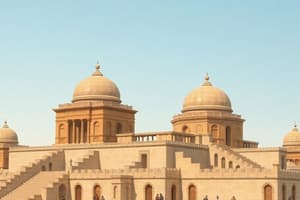Podcast
Questions and Answers
What type of bricks were primarily used for important structures in Assyria and Babylon?
What type of bricks were primarily used for important structures in Assyria and Babylon?
- Sun-dried bricks
- Wooden bricks
- Kiln-dried bricks (correct)
- Stone bricks
The Tigris and Euphrates rivers are known as the 'fertile crescent'.
The Tigris and Euphrates rivers are known as the 'fertile crescent'.
True (A)
Name one of the four main civilizations located in Mesopotamia.
Name one of the four main civilizations located in Mesopotamia.
Sumer
Structures in Persia primarily utilized ___ and colored limestone.
Structures in Persia primarily utilized ___ and colored limestone.
Match the following civilizations with their architectural features:
Match the following civilizations with their architectural features:
Which of the following structures was erected by King Nebuchadnezzar II?
Which of the following structures was erected by King Nebuchadnezzar II?
The Assyrians primarily used stone for their buildings instead of mud-brick.
The Assyrians primarily used stone for their buildings instead of mud-brick.
Who is known as the father of the Iranian Nation?
Who is known as the father of the Iranian Nation?
The architectural style of Persia is characterized by __________ and trabeated construction.
The architectural style of Persia is characterized by __________ and trabeated construction.
Match the following rulers with their notable contributions:
Match the following rulers with their notable contributions:
Which of the following structures is known as the largest archaeological site in the Middle East?
Which of the following structures is known as the largest archaeological site in the Middle East?
The Great Ziggurat of Ur was dedicated to the sun god.
The Great Ziggurat of Ur was dedicated to the sun god.
What were Lamassu sculptures primarily used for?
What were Lamassu sculptures primarily used for?
The __________ was known for its colorful tiles and decorative friezes of bulls and dragons.
The __________ was known for its colorful tiles and decorative friezes of bulls and dragons.
Match the following locations with their corresponding features:
Match the following locations with their corresponding features:
Which king is associated with the construction of the Palace of Persepolis?
Which king is associated with the construction of the Palace of Persepolis?
The __________ was noted for being the first palace in world history.
The __________ was noted for being the first palace in world history.
Small windows with lintels were a characteristic architectural feature of Assyrian structures.
Small windows with lintels were a characteristic architectural feature of Assyrian structures.
Study Notes
Overview of West Asiatic Architecture
- Known as Mesopotamian architecture, marked by massive, monumental structures symbolizing grandeur.
- "Mesopotamia" means "in between rivers," referring to the Tigris and Euphrates rivers, within the geographical region historically known as the Fertile Crescent.
Civilizations in Mesopotamia
- Major civilizations: Sumer (Iraq), Babylon (Iraq), Assyria (Northern Iraq & Southeastern Turkey), and Persia (Iran).
Geological Aspects
- Assyria and Babylon utilized clay for construction, featuring different brick types:
- Sun-dried bricks for ordinary buildings.
- Kiln-dried bricks for important structures.
- Color-glazed bricks for decorative uses.
- Persian architecture involved timber and colored limestone.
Climactic Adaptations
- Assyrian and Babylonian temples built on platforms to avoid flooding, exemplified by ziggurats.
- Persian architecture favored open buildings to combat extreme heat.
- General trend of constructing courtyard forms to adapt to desert conditions.
Religious Significance
- Architectural decorations often included king-headed winged lions, bulls, and mythological creatures in Persia.
- Ziggurats served as temples built on elevated platforms to symbolize a connection to the heavens.
Historical Context
- Sumerians known for monumental temples constructed from sun-dried and glazed bricks; often built on pre-existing structures.
- Babylon's architecture featured mud-brick constructions with decorative pilasters and glazed brickwork, including famous structures like the Tower of Babel.
- Assyrian architecture marked by mud-brick buildings with monumental stone carvings; temples became less significant compared to palaces.
Key Personalities and Their Contributions
- Ur-Nammu: Constructed the Great Ziggurat of Ur.
- Nebuchadnezzar II: Built the Great Palace, Ishtar Gate, and Hanging Gardens of Babylon.
- Hammurabi: Noted for writing the first code of laws, known as Hammurabi’s Code.
- Sargon II: Established the Palace of Sargon in Khorsabad.
- Sennacherib: Moved Assyrian capital to Nineveh.
- Cyrus the Great: Founded the Persian Empire.
- Xerxes I: Extensively constructed the Palace of Persepolis, including the Throne Hall.
- Artaxerxes I: Completed the Palace of Persepolis.
Architectural Differences Among Civilizations
- Construction Methods: Babylon and Assyria emphasized arches and vaults; Persia focused on columnar and trabeated methods.
- Building Types: Babylonian structures showcased massiveness; Persian architecture displayed lighter, airy designs.
- Wall Structures: Babylon and Assyria used white-washed burnt bricks, while Persia constructed double mud brick walls.
- Openings: Babylon and Assyria lacked windows; used terracotta pipes for ventilation. Persian structures included small windows.
Notable Structures in Mesopotamia
- Ziggurats: Multi-tiered temple towers symbolizing sacred mountains, built with mud brick and buttressed walls; accessible only to priests.
- Great Ziggurat of Ur: Erected by King Ur-Nammu, dedicated to the moon god.
- Ishtar Gate: A decorated portal in Babylon adorned with glazed tiles and friezes, reconstructed outside Iraq.
- Hanging Gardens of Babylon: Considered one of the Seven Wonders of the Ancient World, created for Queen Amytis.
- Palace of Persepolis: Founded by Darius I, completed by Xerxes I and Artaxerxes I, included notable sections like the Gate of All Nations and the Hall of the Hundred Columns.
Studying That Suits You
Use AI to generate personalized quizzes and flashcards to suit your learning preferences.
Related Documents
Description
Explore the grandeur of Mesopotamian architecture, marked by monumental structures and unique building materials. Learn about the major civilizations such as Sumer, Babylon, Assyria, and Persia, and discover their distinct architectural features and adaptations to their environment.




